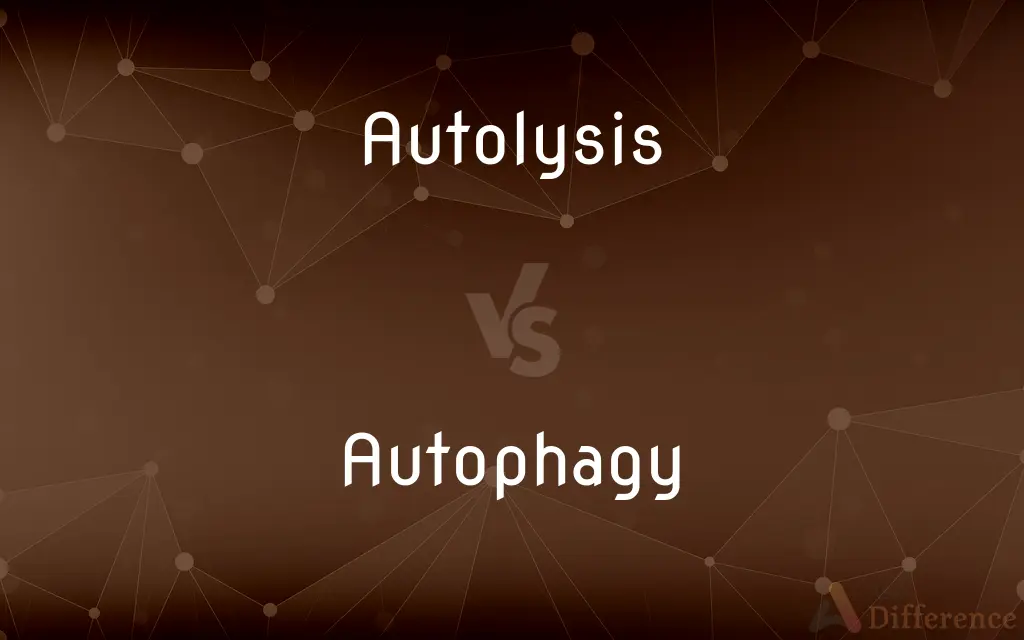Autolysis vs. Autophagy — What's the Difference?
By Urooj Arif & Fiza Rafique — Updated on March 11, 2024
Autolysis is the self-digestion of cells by their own enzymes post-mortem, while autophagy is a cellular process recycling components during living conditions.

Difference Between Autolysis and Autophagy
Table of Contents
ADVERTISEMENT
Key Differences
Autolysis and autophagy are both processes involving the breakdown of cellular components, but they occur under different conditions and serve distinct purposes. Autolysis, also known as self-digestion, typically occurs after a cell has died, where it breaks down its own components through the action of its own enzymes. This process is often observed in the context of tissue degradation after death. On the other hand, autophagy is a controlled, vital process that occurs in living cells, allowing them to degrade and recycle their own components as a means of cellular maintenance and survival under stress conditions.
Autolysis plays a significant role in the decomposition of organisms after death, contributing to the breakdown and recycling of organic matter in ecosystems. It is also an important consideration in food science, where the autolytic enzymes of yeast, for example, are utilized in the production of various food products. Conversely, autophagy is crucial for cell health, involved in responses to starvation, infection, and disease; it helps cells cope with stress by breaking down damaged or surplus organelles and proteins to reuse their building blocks for essential processes.
The regulation of these processes highlights their differences; autolysis is largely unregulated, proceeding as a result of cell death and the release of enzymes that were once contained within lysosomes or other organelles. Autophagy, however, is tightly regulated, with specific signaling pathways initiating and directing the autophagic process to maintain cellular homeostasis and adapt to changing environmental conditions.
While both autolysis and autophagy involve lysosomal enzymes in the degradation of cellular components, the context and implications of these processes are markedly different. Autolysis contributes to the final breakdown of cells after death, whereas autophagy is a dynamic process that supports life by managing cellular resources and removing damaged components.
Understanding the distinction between autolysis and autophagy provides insight into the broader concepts of death and survival at the cellular level. Autolysis represents the end point of cellular life, leading to the breakdown and return of organic material to the environment, while autophagy exemplifies the cellular mechanisms of adaptation, survival, and renewal that are fundamental to life's continuity.
ADVERTISEMENT
Comparison Chart
Definition
Self-digestion of cells by their own enzymes after death
Cellular process that recycles components under stress
Occurs In
Dead cells
Living cells
Role
Decomposition, breakdown of organic matter
Cellular maintenance, survival under stress
Regulation
Largely unregulated
Tightly regulated, with specific signaling pathways
Purpose
Contributes to tissue degradation, recycling in nature
Promotes cell health, manages stress, disease response
Compare with Definitions
Autolysis
Important in forensic science.
Forensic experts study the extent of autolysis to estimate time of death.
Autophagy
Contributes to longevity.
Enhanced autophagy is associated with increased lifespan in several models.
Autolysis
Cell self-digestion post-mortem.
Autolysis begins in the cells of an organism soon after death.
Autophagy
Vital for cellular maintenance.
Autophagy removes damaged organelles, preventing cellular damage.
Autolysis
Contributes to decomposition.
In the wine-making process, autolysis of yeast cells enhances flavor.
Autophagy
Supports adaptation to stress.
Autophagy plays a key role in the cellular response to infection.
Autolysis
Involves breakdown by own enzymes.
Autolytic enzymes cause the softening of tissues during decomposition.
Autophagy
Cellular recycling mechanism.
Autophagy helps cells survive nutrient deprivation by recycling components.
Autolysis
Unregulated process.
Once triggered by cell death, autolysis proceeds without regulation.
Autophagy
Regulated by signaling pathways.
Starvation triggers specific signals that activate autophagy in cells.
Autolysis
The breaking down of cells or tissues by their own enzymes. Also called self-digestion.
Autophagy
(cytology) The process of self-digestion by a cell through the action of enzymes originating within the same cell. Often a defensive and/or self-preservation measure.
Autolysis
The destruction of an organism's cells by enzymes produced by the organism itself.
Autophagy
Autophagy (or autophagocytosis) (from the Ancient Greek αὐτόφαγος autóphagos, meaning "self-devouring" and κύτος kýtos, meaning "hollow") is the natural, conserved degradation lysosome-dependent regulated mechanism of the cell that removes unnecessary or dysfunctional components. It allows the orderly degradation and recycling of cellular components.
Autolysis
(pathology) The autodigestion of the tissues of an organism.
Autophagy
The process of self-digestion by a cell through the action of enzymes originating within the same cell.
Autolysis
(wine) The decomposition of dead yeast cells in wine after fermentation.
Autophagy
(cytology) A type of programmed cell death accomplished through self-digestion.
Autolysis
(baking) A two-stage mixing process where water and flour are combined first before adding leavening and salt.
Autophagy
(rare) Self-consumption; the act of eating oneself.
Autolysis
Lysis of cells or tissues due to enzymatic activity from within the cell, as contrasted with externally induced lysis.
Autophagy
The feeding of the body upon itself, as in fasting; nutrition by consumption of one's own tissues.
Autolysis
Lysis (self-digestion) of tissues when they are detached from the organism
Common Curiosities
Is autolysis a form of cell death?
Autolysis occurs after the cell has died, marking the process of self-digestion that follows death.
Is autophagy only beneficial?
While generally beneficial, excessive or dysregulated autophagy can contribute to disease states.
Does autophagy occur in all cells?
Yes, autophagy is a fundamental process present in almost all eukaryotic cells.
Can autolysis be controlled?
In living organisms, autolysis is not controlled, but conditions affecting its rate, such as temperature, can be managed.
Is autophagy involved in disease?
Yes, autophagy plays complex roles in various diseases, including cancer, neurodegeneration, and infections.
Can autophagy be artificially induced?
Yes, certain drugs and dietary approaches can induce autophagy, offering potential therapeutic benefits.
Are there diseases associated with impaired autophagy?
Yes, impaired autophagy is linked to several diseases, including neurodegenerative diseases and metabolic disorders.
Can autophagy prevent autolysis?
Autophagy can prolong cell health and delay cell death by recycling damaged components, but it cannot prevent autolysis once the cell has died.
How is autolysis detected?
Autolysis can be detected through physical changes in tissues or specific biochemical markers indicating enzyme activity.
Can autolysis happen in plants?
Yes, autolysis can occur in plant cells, contributing to processes such as leaf senescence.
What triggers autolysis?
Cell death triggers autolysis, leading to the release of enzymes that break down the cell from within.
How does autophagy affect aging?
Autophagy reduces the accumulation of damaged components, potentially slowing the aging process.
How is autophagy regulated?
Autophagy is regulated by complex signaling networks that respond to cellular and environmental cues.
Does autolysis serve a purpose in living organisms?
While autolysis occurs post-mortem, it contributes to the recycling of organic material in ecosystems.
Is there a way to measure autophagy?
Yes, autophagy can be measured using various biochemical and microscopic techniques to assess the formation of autophagosomes and the degradation of autophagic cargo.
Share Your Discovery

Previous Comparison
Adverb vs. Proverb
Next Comparison
Jarl vs. EarlAuthor Spotlight
Written by
Urooj ArifUrooj is a skilled content writer at Ask Difference, known for her exceptional ability to simplify complex topics into engaging and informative content. With a passion for research and a flair for clear, concise writing, she consistently delivers articles that resonate with our diverse audience.
Co-written by
Fiza RafiqueFiza Rafique is a skilled content writer at AskDifference.com, where she meticulously refines and enhances written pieces. Drawing from her vast editorial expertise, Fiza ensures clarity, accuracy, and precision in every article. Passionate about language, she continually seeks to elevate the quality of content for readers worldwide.
















































